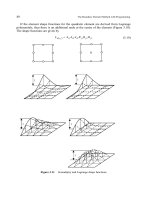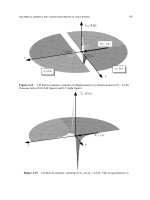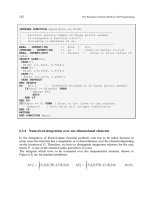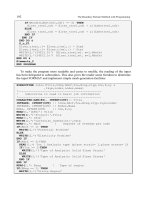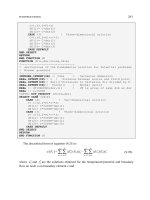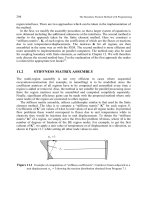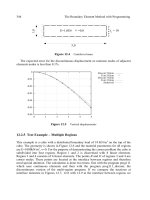The time discrete method of lines for options and bonds a PDE approach
Bạn đang xem bản rút gọn của tài liệu. Xem và tải ngay bản đầy đủ của tài liệu tại đây (17.42 MB, 287 trang )
9292_9789814619677_TP.indd 1
9/10/14 2:43 pm
May 2, 2013
14:6
BC: 8831 - Probability and Statistical Theory
This page intentionally left blank
PST˙ws
World Scientific
9292_9789814619677_TP.indd 2
9/10/14 2:43 pm
Published by
World Scientific Publishing Co. Pte. Ltd.
5 Toh Tuck Link, Singapore 596224
USA office: 27 Warren Street, Suite 401-402, Hackensack, NJ 07601
UK office: 57 Shelton Street, Covent Garden, London WC2H 9HE
British Library Cataloguing-in-Publication Data
A catalogue record for this book is available from the British Library.
THE TIME-DISCRETE METHOD OF LINES FOR OPTIONS AND BONDS
A PDE Approach
Copyright © 2015 by World Scientific Publishing Co. Pte. Ltd.
All rights reserved. This book, or parts thereof, may not be reproduced in any form or by any means,
electronic or mechanical, including photocopying, recording or any information storage and retrieval
system now known or to be invented, without written permission from the publisher.
For photocopying of material in this volume, please pay a copying fee through the Copyright Clearance
Center, Inc., 222 Rosewood Drive, Danvers, MA 01923, USA. In this case permission to photocopy
is not required from the publisher.
ISBN 978-981-4619-67-7
In-house Editor: Qi Xiao
Printed in Singapore
QiXiao - The Time-Discrete Method of Lines.indd 1
7/11/2014 9:34:15 AM
23 September 2014
16:36
BC: 9292 - The Time-Discrete Methods of Lines for Options and Bonds
BookGHM
Preface
In these notes we discuss some of the issues which arise when the partial
differential equations (pdes) modeling option and bond prices are to be
solved numerically. A great variety of numerical methods for this task can
be found in textbooks and the research literature, and all are effective for
pricing Black Scholes options on a single asset and bonds based on a onefactor interest rate model, particularly when prices far enough away from
expiration are to be found.
However, there are financial applications where pde methods have to
cope with uncertainty in the problem description, with rapidly changing
solutions and their derivatives, with nonlinearities, non-local effects, vanishing diffusion in the presence of strong convection, and the “curse of
dimensionality” due to multiple assets and factors in the financial model.
All these complications are inherent in the pde formulation and must be
overcome by whatever numerical method is chosen to price options and
bonds accurately and efficiently.
The focus of these notes is on identifying and discussing these complications, to remove uncertainty in the pde model due to incomplete or inconsistent boundary data, and to illustrate through extensive simulations
the computational problems which the pde model presents for its numerical
solution. We concentrate on pricing models which have been presented in
the literature, and for which results have been obtained with various numerical methods for specific applications. Here we shall search out problem
settings where the complications in the pde formulation can be expected to
degrade the numerical results.
We do not discuss different numerical methods for the pdes of finance
and their effectiveness in solving practical problems. All simulations will be
carried out with the time-discrete method of lines. We view it as a flexible
v
page v
23 September 2014
16:36
BC: 9292 - The Time-Discrete Methods of Lines for Options and Bonds
BookGHM
vi The Time-Discrete Method of Lines for Options and Bonds — A PDE Approach
tool for solving low-dimensional time dependent pricing problems in finance.
It is based on a solution method which for simple American puts and calls
is algorithmically equivalent to the Brennan-Schwartz method. For multidimensional problems it is combined with a locally one-dimensional line
Gauss Seidel iteration. The method is introduced in detail in these notes.
We think that it performs well enough that we offer the results of our simulations as benchmark data for a variety of challenging financial applications
to which competing numerical methods could be applied.
The notes are intended for readers already engaged in, or contemplating, solving numerically partial differential equations for options and bonds.
The notes are written by a mathematician, but not for mathematicians.
They are “applied” and intended to be accessible for graduates of programs
in quantitative and computational finance and practicing quants who have
learned about numerical methods for the Black Scholes equation, the bond
equation, and their generalisations. But we also assume that the readers have not had a particular exposure to, or interest in, the theory of
partial differential equations and the mathematical analysis of numerical
method for solving them. There are many sources in the textbook and
research literature on both aspects, a notable example being the rigorous
textbook/monograph of Achdou and Pironneau [1]. But such sources would
appeal more to specialists than to the readership we hope to reach.
These notes are not a text for a course on numerical methods for the
pdes of finance, nor are they intended to answer real questions in finance.
The pde models discussed at length below are drawn from various published
sources and readers are referred to the cited literature for their derivation
and discussion. On occasion the models will be modified because finance
suggests it or mathematics demands it. They will be solved numerically
with assumed data, frequently chosen to accentuate the severity of the
application and the behavior of the solution. Financial implications of our
results will mostly be ignored. Although not a textbook, this book could
serve as a reference for an advanced applied course on pdes in finance
because it discusses a number of topics germain to all numerical methods
in this field regardless of whether the method of lines is ever mentioned.
Both the pde problem specification and its numerical solution will be
of interest. We shall assume that given a financial model for the evolution
of an asset price, a volatility, an interest rate, etc., the pricing pde can be
derived under specific assumptions reflecting or approximating the market
reality. The validity of the pde, usually a time dependent diffusion equation,
is not considered in doubt.
page vi
23 September 2014
16:36
BC: 9292 - The Time-Discrete Methods of Lines for Options and Bonds
Preface
BookGHM
vii
However, the pde does not constitute the whole model. The pde is only
solvable if the problem for it is (in the language of mathematics) “well
posed”, meaning that it has a solution, that the solution is unique, and
that the solution varies continuously with the data of the problem. If the
pde is to be solved numerically, then in general it must be restricted to a
finite computational domain. In order to be well posed an initial condition
and the behavior on the boundary of the computational domain must be
given. The initial condition is usually the pay-off of the option or the value
of the bond at expiration, both of which are unambiguous and consistent
with the pricing problem being well posed. For options the pay-off tends to
introduce singularities into the solution or its derivatives which can make
pricing of even simple options like puts and calls near maturity a challenging
numerical problem.
In contrast to the certainty about initial conditions, the proper choice
of boundary conditions can be complicated. The structure of the pdes arising in finance can exert a dominant influence on what boundary conditions
can be given, and where, to retain a well-posed problem. This is often
not a question of finance but relates to a fairly recent and still incomplete
mathematical analysis of admissible boundary conditions for so-called degenerate evolution equations. While the mathematical theory is likely to be
too abstract for the intended readership of these notes, we hope that sufficient operational information has been extracted from it to give guidance
for choosing admissible boundary conditions. The most difficult case arises
when for lack of better information a modification of the pde itself is used
to set a boundary condition on a computational boundary. This aspect of
the pde model is independent of the numerical method chosen for its solution. However, mathematically admissible boundary conditions are usually
not unique. Some preserve the structure of the boundary value problem required for the intended numerical method but are inconsistent financially,
while other admissible boundary conditions may be harder to incorporate
into a numerical method but may yield solutions which are less driven by
where we place the computational boundary. Simulation seems the only
choice to check how uncertain boundary data will affect the solution.
The book has seven chapters. Section 1.1 of the first chapter reflects the
view that once a well-posed mathematical model is accepted, then the solution is unambiguously determined and its mathematical properties must
be acceptable on financial grounds. The examples of this section are based
on elementary mathematical manipulations of the Black Scholes equation
and its extensions and formally prove results which often are obvious from
page vii
23 September 2014
16:36
BC: 9292 - The Time-Discrete Methods of Lines for Options and Bonds
BookGHM
viii The Time-Discrete Method of Lines for Options and Bonds — A PDE Approach
arbitrage arguments. Section 1.2 concentrates on a discussion of admissible boundary conditions for degenerate pricing equations in finance. It
introduces the Fichera function as a tool to determine where on the boundary of its domain of definition the pricing equation has to hold, and where
unrelated conditions can be imposed. We illustrate the application of the
Fichera function for a number of option problems including cases where
boundary conditions at infinity have to be set. We then consider the problem of conditions on the boundary of a finite computational domain where
financial arguments often do not provide boundary conditions. We show
that reduced versions of the pde can provide acceptable tangential boundary conditions known as Venttsel boundary conditions.
Chapter 2 introduces the method of lines for a scalar diffusion equation
with one or two free boundaries. It will then be combined with a line GaussSeidel iteration to yield a locally one-dimensional front tracking method for
time-discretized multi-dimensional diffusion problems subject to fixed and
free boundary conditions.
Chapter 3 discusses in detail the numerical solution of the one- dimensional problems with the so-called Riccati transformation. It is closely
related to the Thomas algorithm for the tri-diagonal matrix equation approximating linear second order two-point boundary value problems and is
equally efficient.
The next four chapters consist of numerical simulations of options and
bonds. The numerical method chosen for the simulations is always the
method of lines of the preceding two chapters, but the numerical method
intrudes little on the discussion of the pde model and the quality of its
solutions.
Chapters 4 and 5 deal with European and American options priced
with the Black Scholes equation. Comparisons with analytic solutions,
where available, give the sense that such options can be computed to a
high degree of accuracy even near expiration.
Chapter 6 concentrates on fixed income problems based on general
one-factor interest rate models, including those admitting negative interest
rates.
The experience gained with scalar diffusion problems is brought to bear
in Chapter 7 on options for two assets, including American max and min
options. It is shown that on occasion front tracking algorithms for American
options can benefit by working in polar coordinates when the early exercise
boundary on discrete rays is a well defined function of the polar angle.
The last example of an American call with stochastic volatility and
page viii
23 September 2014
16:36
BC: 9292 - The Time-Discrete Methods of Lines for Options and Bonds
Preface
BookGHM
ix
interest rate suggests that the application of a locally one-dimensional front
tracking method remains feasible in principle but presents hardware and
programming challenges not easily met by the linear Fortran programs and
the desktop computer used for our simulations.
Throughout these notes we give, besides graphs, a lot of tabulated data
obtained with the method of lines for a variety of financial problems. Such
data may prove useful as benchmark results for the implementation of the
method of lines or other numerical methods for related problems. As already stated, the financial parameters are only assumed, but our numerical
simulations appear to be robust over large parameter ranges for all the
models discussed here. This may help when the method of lines is applied
as a general forward solver in a model calibration.
Finally, we will admit that the choice of financial models treated here
is more a reflection on past exposure, experience and taste than an orderly
progression from simple to complicated models, or from elementary to relevant models. Our judgment of what questions are relevant in finance is
informed by the texts of Hull [38] and Wilmott [64], while the more mathematical thoughts were inspired by the texts of Kwok [46] and Zhu, Wu
and Chern [67], which we value for their breadth and mathematical precision. So far, the method of lines has proved to be a flexible and effective
numerical method for pricing options and bonds, and as demonstrated in
a concurrent monograph of Chiarella et al. [17], it can hold its own against
some competing numerical methods for pdes in finance. MOL cannot work
for all problems, but we do not hide its failures.
G. H. Meyer
page ix
May 2, 2013
14:6
BC: 8831 - Probability and Statistical Theory
This page intentionally left blank
PST˙ws
23 September 2014
16:36
BC: 9292 - The Time-Discrete Methods of Lines for Options and Bonds
BookGHM
Contents
Preface
v
Acknowledgment
1.
xv
Comments on the Pricing Equations in Finance
1
1.1
2
1.2
Solutions and their properties . . . . . . . . . . . . . . . .
Example 1.1 Positivity of option prices and the Black
Scholes formulas . . . . . . . . . . . . . . . . . . .
Example 1.2 The early exercise boundary for plain American puts and calls . . . . . . . . . . . . . . . . . .
Example 1.3 Exercise boundaries for options with jump
diffusion . . . . . . . . . . . . . . . . . . . . . . .
Example 1.4 The early exercise premium for an American
put . . . . . . . . . . . . . . . . . . . . . . . . . .
Example 1.5 The early exercise premium for an American
call . . . . . . . . . . . . . . . . . . . . . . . . . .
Example 1.6 Strike price convexity . . . . . . . . . . . . .
Example 1.7 Put-call parity . . . . . . . . . . . . . . . . .
Example 1.8 Put-call symmetry for a CEV and Heston
model . . . . . . . . . . . . . . . . . . . . . . . . .
Example 1.9 Equations with an uncertain parameter . . .
Boundary conditions for the pricing equations . . . . . . .
1.2.1 The Fichera function for degenerate equations . .
Example 1.11 Boundary conditions for the heat equation .
Example 1.12 Boundary condition for the CEV Black
Scholes equation at S = 0 . . . . . . . . . . . . . .
xi
5
8
10
12
14
15
16
19
23
27
29
33
34
page xi
23 September 2014
16:36
BC: 9292 - The Time-Discrete Methods of Lines for Options and Bonds
BookGHM
xii The Time-Discrete Method of Lines for Options and Bonds — A PDE Approach
Example 1.13 Boundary conditions for a discount bond at
r=0 . . . . . . . . . . . . . . . . . . . . . . . . .
Example 1.14 Boundary conditions for the Black Scholes
equation on two assets . . . . . . . . . . . . . . . .
Example 1.15 Boundary conditions for the Black Scholes
equation with stochastic volatility v at S = 0 and
v=0 . . . . . . . . . . . . . . . . . . . . . . . . .
Example 1.16 Boundary conditions for an Asian option . .
1.2.2 The boundary condition at “infinity” . . . . . . .
Example 1.17 CEV puts and calls . . . . . . . . . . . . . .
Example 1.18 Puts and calls with stochastic volatility . .
Example 1.19 The European max option . . . . . . . . . .
Example 1.20 An Asian average price call . . . . . . . . .
1.2.3 The Venttsel boundary conditions on “far but
finite” boundaries . . . . . . . . . . . . . . . . . .
Example 1.21 A defaultable bond . . . . . . . . . . . . . .
Example 1.22 The Black Scholes equation with stochastic
volatility . . . . . . . . . . . . . . . . . . . . . . .
1.2.4 Free boundaries . . . . . . . . . . . . . . . . . . .
2.
The Method of Lines (MOL) for the Diffusion Equation
2.1
2.2
2.3
2.4
3.
The method of lines with continuous time
(the vertical MOL) . . . . . . . . . . . . . . . . . . . . . .
The method of lines with continuous x
(the horizontal MOL) . . . . . . . . . . . . . . . . . . . .
Appendix 2.2 Stability of the time discrete three-level
scheme for the heat equation . . . . . . . . . . . .
The method of lines with continuous x for multidimensional problems . . . . . . . . . . . . . . . . . . . . .
Appendix 2.3 Convergence of the line Gauss Seidel
iteration for a model problem . . . . . . . . . . . .
Free boundaries and the MOL in two dimensions . . . . .
35
37
38
40
42
42
44
45
47
48
50
52
54
57
58
61
63
64
69
71
The Riccati Transformation Method for Linear Two
Point Boundary Value Problems
75
3.1
3.2
3.3
76
79
81
The Riccati transformation on a fixed interval . . . . . . .
The Riccati transformation for a free boundary problem .
The numerical solution of the sweep equations . . . . . . .
page xii
23 September 2014
16:36
BC: 9292 - The Time-Discrete Methods of Lines for Options and Bonds
BookGHM
Contents
xiii
Example 3.1 A real option for interest rate sensitive
investments . . . . . . . . . . . . . . . . . . . . . .
Appendix 3.3 Connection between the Riccati transformation, Gaussian elimination and the BrennanSchwartz method . . . . . . . . . . . . . . . . . .
4.
European Options
87
88
93
Example 4.1 A plain European call . . . . . . . . . . . . . 96
Example 4.2 A binary cash or nothing European call . . . 101
Example 4.3 A binary call with low volatility . . . . . . . 107
Example 4.4 The Black Scholes Barenblatt equation for a
CEV process . . . . . . . . . . . . . . . . . . . . . 111
5.
American Puts and Calls
Example 5.1 An American put . . . . . . . . . . . . .
Example 5.2 An American put with sub-optimal early
exercise . . . . . . . . . . . . . . . . . . . . . .
Example 5.3 A put on an asset with a fixed dividend .
Example 5.4 An American lookback call . . . . . . . .
Example 5.5 An American strangle for power options .
Example 5.6 Jump diffusion with uncertain volatility .
6.
117
. . 117
.
.
.
.
.
.
.
.
.
.
Bonds and Options for One-Factor Interest Rate Models
Example 6.1 The Ho Lee model . . . . . . . . . . . . . . .
Example 6.2 A one-factor CEV model . . . . . . . . . . .
Example 6.3 An implied volatility for a call on a discount
bond . . . . . . . . . . . . . . . . . . . . . . . . .
Example 6.4 An American put on a discount bond . . . .
7.
123
125
129
135
141
153
158
161
165
171
Two-Dimensional Diffusion Problems in Finance
181
7.1
185
Front tracking in Cartesian coordinates . . . . . . . . . . .
Example 7.1 An American call on an asset with stochastic
volatility. . . . . . . . . . . . . . . . . . . . . . . .
Example 7.2 A European put on a combination of two
assets . . . . . . . . . . . . . . . . . . . . . . . . .
Example 7.3 A perpetual American put – MOL with overrelaxation . . . . . . . . . . . . . . . . . . . . . . .
Example 7.4 An American call, its deltas and a vega . . .
185
190
197
199
page xiii
23 September 2014
16:36
BC: 9292 - The Time-Discrete Methods of Lines for Options and Bonds
BookGHM
xiv The Time-Discrete Method of Lines for Options and Bonds — A PDE Approach
7.2
7.3
Example 7.5 American spread and exchange options . . .
Example 7.6 An American call option on the maximum of
two assets . . . . . . . . . . . . . . . . . . . . . . .
American calls and puts in polar coordinates . . . . . . .
Example 7.7 The basket call in polar coordinates . . . . .
Example 7.8 A call on the minimum of two assets . . . . .
Example 7.9 A put on the minimum of two assets . . . . .
Example 7.10 A perpetual put on the minimum of two
assets with uncertain correlation . . . . . . . . . .
Example 7.11 Implied correlation for a put on the sum of
two assets . . . . . . . . . . . . . . . . . . . . . . .
A three-dimensional problem . . . . . . . . . . . . . . . .
Example 7.12 An American call with Heston volatility and
a stochastic interest rate . . . . . . . . . . . . . .
207
212
220
221
223
229
237
239
245
246
Bibliography
261
Index
265
About the Author
269
page xiv
25 September 2014
15:57
BC: 9292 - The Time-Discrete Methods of Lines for Options and Bonds
BookGHM
Acknowledgment
I am grateful to the School of Mathematics of the Georgia Institute of Technology for remaining my scientific home in the years since my retirement.
Interaction with colleagues, teaching the occasional course, and having access to the resources of the School and the Institute have made this time
an unbroken, and unexpected, sabbatical.
The most important resource has been the cooperation of Ms. Annette
Rohrs of the School in producing this book. In spite of a varied and steadily
expanding workload, she has once again managed to turn scribbled and ever
changing notes into a camera-ready book. Without her help I would not
have started this project and could not have finished it. Thank you again,
Annette.
xv
page xv
May 2, 2013
14:6
BC: 8831 - Probability and Statistical Theory
This page intentionally left blank
PST˙ws
25 August 2014
10:33
BC: 9292 - The Time-Discrete Methods of Lines for Options and Bonds
BookGHM
Chapter 1
Comments on the Pricing Equations
in Finance
The two dominant pricing equations of these notes are the Black Scholes
equation for the price V (S, t) of an option
1
(1.1)
LBS V ≡ σ 2 S 2 VSS + (r − q)SVS − rV − Vt = 0
2
for 0 < S < ∞ and t ∈ (0, T ], and the bond equation for the price B(r, t)
of a discount bond
1
(1.2)
LB B ≡ w2 Brr + (u − λw)Br − rB − Bt = 0
2
for, usually, 0 < r < ∞ and t ∈ (0, T ], where t = T − τ for calendar time
τ denotes the time to expiry. Both equations are augmented by the values
V (S, 0) and B(r, 0) at expiration t = 0 and by boundary conditions on V
and B which are determined by the specific application. The aim is to
find “a solution” of the pricing equation which also satisfies the given side
conditions.
These equations, and their multi-factor generalizations, are special
forms of a so-called evolution equation
m
Lu ≡
m
aij (x, t)uxi xj +
i,j=1
bi (x, t)uxi + c(x, t)u
(1.3)
i=1
+ d(x, t)ut = f (x, t)
where A = (aij (x, t)) is a symmetric matrix, d(x, t) = 0, and where (x, t) =
(x1 , . . . , xm , t) denotes the m+1 independent variables. Typically x belongs
to an open bounded or unbounded set D(t) in Rm with boundary ∂D(t),
and t belongs to an interval (0, T ]. We remark that time dependent domains
D(t) are common in the free boundary formulation of American options.
If the matrix A in (1.3) is positive definite then the equation is known as
a parabolic or, somewhat imprecisely, a diffusion equation. In finance the
1
page 1
25 August 2014
2
10:33
BC: 9292 - The Time-Discrete Methods of Lines for Options and Bonds
BookGHM
The Time-Discrete Method of Lines for Options and Bonds — A PDE Approach
matrix is often non-negative definite which complicates its analysis. For
simplicity we shall call (1.3) a diffusion equation even if A is only semidefinite.
The most famous example of a diffusion equation is the simple heat
equation for conductive heat transfer
Lu ≡ uxx − ut = 0
which often can be solved analytically. It is well known that the Black
Scholes equation (1.1) for constant parameters can be transformed to the
heat equation through a change of variable, and that the corresponding
Green’s function solutions are the Black Scholes formulas for various European options (see [33] and Example 1.1). When analytic solutions are not
available one usually resorts to numerical solutions.
The partial differential equations of finance are mathematical models
which are derived in many textbooks under specific market assumptions
and simplifications which do not necessarily reflect the market reality (see,
e.g. [64]). But once the model equations and their initial and boundary conditions are accepted, one also has to accept the qualitative and quantitative
behavior of their solutions which is entirely determined by the structure of
the mathematical problem and not the application. One cannot assume a
priori that the mathematical solution will show all the properties which are
obvious for financial reasons. Instead, one has to prove that the mathematical solutions are consistent with financial arguments. If not, the model
would have to be changed.
1.1
Solutions and their properties
The user of the partial differential equations of finance tends to assume
that the mathematical problem has a solution. The user also tends to have
a strong intuitive sense of whether an approximate or numerical solution
is “correct”. To a mathematician the problem is not quite so simple because the meaning of solution is ambiguous. A problem may not have a
solution in one sense but may well have a unique solution if the class of
admissible functions is broadened by allowing certain types of discontinuities. Moreover, an approximate solution may well solve a closely related
problem while the actual formulation does not have any solution.
There is a comprehensive mathematical theory on the existence, uniqueness and properties of solutions of parabolic problems (see, e.g. [28], [47],
page 2
25 August 2014
10:33
BC: 9292 - The Time-Discrete Methods of Lines for Options and Bonds
Comments on the Pricing Equations in Finance
BookGHM
3
[48], and research on its extensions continues unabated. Here, to characterize solutions of differential equations without going into technical detail,
the following few (very loose) definitions are convenient:
Definition. A function u is smooth if it has as many continuous derivatives
as are needed for the operations to which it is subjected.
Definition. A classical solution of (1.3) subject to an initial condition at
t = 0 and to boundary conditions on ∂D(t) is a function which is continuous
on the closed set D(t) × [0, T ], smooth on D(t) × (0, T ], and which satisfies
point for point the equation and the initial and boundary conditions.
Definition. A weak solution is a function which satisfies the equation (1.3)
and the side conditions in an “integral sense” (see, e.g. Section 1.2.1).
For example, the Black Scholes formula for a European put is a classical
solution of the Black Scholes equation (1.1) and the pay-off and boundary
conditions
V (S, 0) = max{0, K − S}
V (0, t) = Ke−rt ,
lim V (S, t) = 0
S→∞
while the Black Scholes formula for a European digital call with initial
condition
V (S, 0) =
0 S
is not a classical solution because V (S, 0) is discontinuous at the strike
price K. Similarly, the solution for an up (or down) and out barrier option
generally has a discontinuity at expiration at the barrier and is therefore
only a weak solution. We mention that classical solutions are always weak
solutions.
Many of the conceptual problems due to discontinuous initial/boundary
conditions can be circumvented if we think of approximating the data by
continuous functions. For example, the digital call V (S, t) may be defined
as
V (S, t) = lim V (S, t)
→0
where
⎧
⎪
⎪
⎨0
V (S, 0) =
S
(S − (K − ))/(2 ) K − ≤ S ≤ K + .
⎪
⎪
⎩1
S>K+
page 3
25 August 2014
4
10:33
BC: 9292 - The Time-Discrete Methods of Lines for Options and Bonds
BookGHM
The Time-Discrete Method of Lines for Options and Bonds — A PDE Approach
The existence theory for diffusion equations implies that V (S, t) is a classical solution of the approximating problem, and theoretical a priori estimates
can be invoked to show that V (S, t) converges to V (S, t) in a mean square
sense. As we shall see in subsequent sections, discontinuous solutions tend
to be difficult to compute accurately.
The existence theory for solutions of parabolic problems can be exceedingly abstract and technical, but a priori information on the properties
of smooth solutions can often be obtained quite simply with the so-called
maximum principle for parabolic equations (see, e.g. [28]). In its simplest
form it is little more than the second derivative test of elementary calculus.
A maximum principle: Consider the Black Scholes equation (1.1) with
r > 0: Let V (S, t) be a smooth function which satisfies
LBS V (S, t) ≤ 0
for S ∈ (0, ∞) and t ∈ (0, T ].
Then V cannot have a negative relative minimum in (0, ∞) × (0, T ].
To prove this assertion we note that if V had a negative relative minimum at some point (S ∗ , t∗ ) then necessarily
rV (S ∗ , t∗ ) < 0
VS (S ∗ , t∗ ) = 0
Vt (S ∗ , t∗ ) ≤ 0
VSS (S ∗ , t∗ ) ≥ 0.
These inequalities would imply that
LBS V (S ∗ , t∗ ) > 0
which contradicts the assumption LBS V ≤ 0. Hence there cannot be a
negative relative minimum.
If LBS V ≥ 0 then an analogous argument rules out the existence of an
interior positive relative maximum of V (S, t).
It is a consequence of the maximum principle that if
LBS V (S, t) = 0,
S0 (t) < S < S1 (t),
t ∈ (0, T ]
then V can attain a negative absolute minimum only either at t = 0 or on
the lateral boundaries S0 (t), S1 (t), t ∈ (0, T ]. Similarly, a positive absolute
maximum can be attained only on the boundary.
Equivalent properties can be deduced for the solution of the bond equation for r > 0. Moreover, the maximum principle can be shown to hold
for the multidimensional equation (1.3). For example, if A(x, t) is positive
semi-definite, if c(x, t) ≤ c0 < 0, and if d(x, t) ≤ 0 then the solution u of
page 4
25 August 2014
10:33
BC: 9292 - The Time-Discrete Methods of Lines for Options and Bonds
Comments on the Pricing Equations in Finance
BookGHM
5
(1.3) cannot have an interior positive relative maximum or negative relative
minimum at any point (x, t) for x ∈ D(t) and t ∈ (0, T ], where D(t) is an
open set in Rm .
We shall now use the tools for partial differential equations to prove
that the Black Scholes option price has properties which are expected on
financial grounds.
Example 1.1. Positivity of option prices and the Black Scholes formulas.
If V (S, t) is a smooth bounded solution of (1.1) defined on [0, ∞) then
it follows from Example 1.12 on p. 34 that
V (0, t) = V (0, 0)e−rt
is the only admissible boundary condition for (1.1) at S = 0. Moreover, if
either
lim V (S, 0) = A or lim VS (S, 0) = B
S→∞
S→∞
then we see from Example 1.17 on p. 42 that
lim V (S, t) = Ae−rt or lim VS (S, 0) = Be−qt
S→∞
S→∞
are the correct asymptotic boundary conditions. If the pay-off V (S, 0) is
non-negative or B > 0, and if the asymptotic condition is imposed at a
barrier X
0, then the maximum principle and the boundary conditions
rule out negative values for V (S, t) on [0, X] × [0, T ] for all X > 0.
If no asymptotic limits are known but V (S, 0) ≥ 0 for all S, and if the
financial parameters in Equation (1.1) are constant, then we can deduce
the positivity of V from its Green’s function representation. Indeed, it is
known from PDE theory [10] that the initial value problem for the heat
equation
Lu ≡ uxx − ut = 0,
−∞ < x < ∞,
t>0
u(x, 0) = f (x)
has a solution of the form
∞
u(x, t) =
−∞
G(x − y, t)f (y)dy
with
2
1
e−x /4t
G(x, t) = √
4πt
(1.4)
page 5
25 August 2014
6
10:33
BC: 9292 - The Time-Discrete Methods of Lines for Options and Bonds
BookGHM
The Time-Discrete Method of Lines for Options and Bonds — A PDE Approach
provided f is such that the integral exists and can be differentiated with
respect to x and t. If f is continuous and satisfies the growth condition
|f (x)| ≤ M eAx
2
for constants A, M > 0,
then (1.4) is a classical solution for t ∈ [0, 1/4A). Moreover, it is the only
solution which satisfies a growth condition like
|u(x, t)| ≤ M eA x
2
for constants M , A .
All other solutions grow faster at infinity and are not relevant for options
and bonds. Note that if f (y) ≡ 1 then u(x, t) ≡ 1 is the only bounded
solution which implies that for all x and for t > 0
∞
−∞
G(x − y, t)dy = 1.
If f is only piecewise continuous with finitely many bounded jumps then
(1.4) still solves the heat equation but
u(x, t) → f (x0 ) as (x, t) → (x0 , 0)
only if x0 is a point of continuity of f .
Note that if f is a continuous mean square approximation of f such
that
∞
−∞
(f (y) − f (y))2 dy ≤
then
∞
u (x, t) =
−∞
G(x − y, t)f (y)dy
is a classical solution which converges pointwise to f (y) as t → 0. It follows
from Schwarz’s inequality that
[u(x, t) − u (x, t)]2 =
≤
=
because G > 0 and
respect to x leads to
∞
−∞
∞
−∞
∞
−∞
∞
G(x − y, t)(f (y) − f (y))dy
G(x − y, t)dy
∞
−∞
2
G(x − y, t)(f (y) − f (y))2 dy
G(x − y, t)(f (y) − f (y)2 )dy
−∞
∞
−∞ G(x
[u(x, t) − u (x, t)]2 dx ≤
− y, t)dy = 1. Integrating both sides with
∞
∞
−∞
−∞
G(x − y, t)(f (y) − f (y)2 )dx dy
page 6
25 August 2014
10:33
BC: 9292 - The Time-Discrete Methods of Lines for Options and Bonds
Comments on the Pricing Equations in Finance
∞
=
−∞
BookGHM
7
(f (y) − f (y))2 dy.
Hence the initial mean square approximation error does not increase with
time which motivates (but does not justify) the smoothing of discontinuous
option pay-offs.
The Black Scholes equation for constant parameters can be transformed
into the heat equation as described in detail in many texts (see, e.g. [67,
p. 107], [64, p. 92], [46, p. 51]). It leads to the following representation of
the solution V of (1.1)
V (S, t) = e−rt u(z, τ )
where
∞
u(z, τ ) =
−∞
G(z − y, τ )V (ey , 0)dy
(1.5)
and
z = ln S + (r − q − σ2 /2)t
τ = σ 2 t/2.
It follows from (1.5) by inspection that for any pay-off V (S, 0) ≥ 0 the
corresponding Black Scholes option price is non-negative.
We note that for any A > 0 and any α ∈ (−∞, ∞) the inequality
|αy| ≤ Ay 2 holds for |y| ≥ |y0 | =
|α|
A
so that
eαy ≤ e|αy| ≤ e|αy0 | eAy
2
for all y.
Therefore, if (1.1) models a power option with pay-off
V (S, 0) = max{0, Q(S)}
where
N
Qi S αi
Q(S) = Q0 +
αi ∈ (−∞, ∞)
i=1
then (1.5) defines a bounded solution for t ∈ [0, ∞).
For piecewise continuous linear pay-offs the integral (1.5) can evaluated
analytically in terms of error functions. Since error functions are nowadays
intrinsic functions in program libraries, we have de facto an analytic solution
for many European option pricing problems [33].
page 7
25 August 2014
8
10:33
BC: 9292 - The Time-Discrete Methods of Lines for Options and Bonds
BookGHM
The Time-Discrete Method of Lines for Options and Bonds — A PDE Approach
The best known pricing formulas describe the plain European put and
call
p(S, t) = Ke−rt N (−d2 ) − Se−qt N (−d1 )
c(S, t) = Se−qt N (d1 ) − Ke−rt N (d2 )
where
d1 =
ln(S/K) + (r − q + σ 2 /2)t
√
σ t
√
d2 = d1 − σ t
1
N (x) = √
2π
x
2
e−s
/2
ds.
−∞
They yield the boundary values
p(0, t) = Ke−rt ,
c(0, t) = 0,
lim p(S, t) = 0
S→∞
lim [c(S, t) − S −qt + Ke−rt ] = 0
S→∞
and conditions on the delta and gamma
lim cS (S, t) = e−qt
S→∞
and
lim CSS (S, t) = 0
S→∞
K
which for numerical methods are frequently enforced at barriers X0
K for options which behave like a European put near S = 0 and
and X1
like a call as S → ∞.
The bond equation cannot in general be transformed into the heat equation. The existence and uniqueness of its solution must be deduced from
the general theory for diffusion equations. However, for special interest rate
models the structure of the solution is known and analytic solutions can be
found.
Example 1.2. The early exercise boundary for plain American puts and
calls.
The solution of an American put will be denoted by {P (S, t), S0 (t)}
where the price P satisfies (1.1) in the so-called continuation region S >
S0 (t) and S0 (t) is the early exercise boundary (a so-called free boundary)
below which P takes on its “intrinsic” value
P (S, t) = K − S,
0 ≤ S ≤ S0 (t).
page 8



